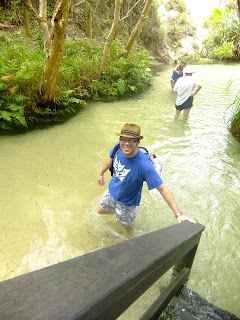Having been driving through several ecological systems including Banksia and Satinay Forests it was such a contrast to find ourselves out in the open with the 75 mile beach highway stretching way into the distance northwards and the Pacific Ocean north south and west with next stop Chile! So far two words viz resort and highway now have new meanings for me!
The highway was the beach, the most beautiful soft white sand with the ocean timelessly and endlessly moving softly towards us. It just seemed so incongruous to see the road signs indicating a 30km limit changing a little later to an 80km limit!
The only barrier to travel is in fact the sea itself and great emphasis is placed on knowing the tides and where you mustn't drive at certain times.......no cones, no contraflow just the odd tour bus and a few visitors in their hired 4x4WDs, more of that tomorrow! The width of the beach was on average the size of 5/6 lanes of motorway and occasionally narrowing to 2/3 lanes width. Really, really magical.
A few kms along our ranger spotted a white-bellied sea-eagle towering over us in a dead tree alongside the beech. Photo through bus window but gives an indication of the large size of this bird.
I was in my element with the ocean on one side and tropical rainforest on the other - no feeling of the constant travel sickness experienced up till now! There are no rocks on the sand only something called coffee rock which is where some minerals have hardened in the sand and changed the colour and the formation somewhat. These rocks apparently can be ground down in your hands...they do look like rock even close up!
We reached Eli Creek, a glorious place to be and basically the only toilet stop en route! Cup of tea and biccie time...maybe one day I'll learn to like tea and biccies! The Creek pours in 4.3 million litres of water per HOUR into the ocean, 6 times greater than the amount of water in Sydney Harbour!
I am certainly learning about Oz wildlife as my companion at the ladies was none other than this enormous, gigantic spider! Not too much variety in their spider population - all ****** big! We then walked along the boardwalk to a viewpoint and decided to come back down to the beach via the creek.
The water was cool and very very clear, a great experience and good fun!
Back on our tank type bus we stopped further along to look at the Maheno Wreck - a trans Tasman Passenger Liner which also served as a hospital ship in World War 1. Sold as scrap to Japan it was being towed northwards when a cyclone hit and it ended up on the shore. After a new life as a target for bombs during World War 11. After many decades of pounding waves and corroding salt it is now a crumbling rusting relic of its former self. It is really sad to see this and compare it to the model of a quite magnificent ship in the hotel foyer.
Next stop was "The Pinnacles" arguably the most spectacular coloured sand formations in Australia. Not very high but ancient, pure sand! Birds gouge out holes to nest build in the spring.
Beach sand appears yellow when nutrients are attached to the grains. As plant roots strip sand of their nutrient coatings, the grain appears white (thinking Achmelvic Bay in Sutherland, Luskentyre on Harris).
Yellow-brown sand contains nutrients and has not yet been completely leached by the vegetation and water. Coloured sand formations occur when wind and rain erodes the more recent windblown sandmass, exposing underlying sands, then moulds these older, harder sands into spectacular sculptures, highly coloured by iron oxides eg The Pinnacles on Fraser Island.







No comments:
Post a Comment